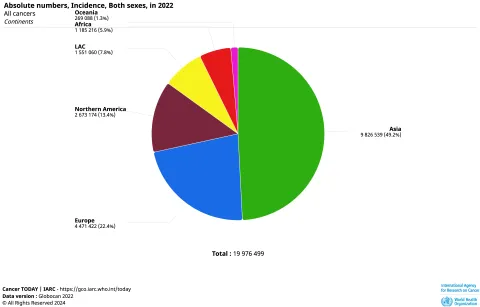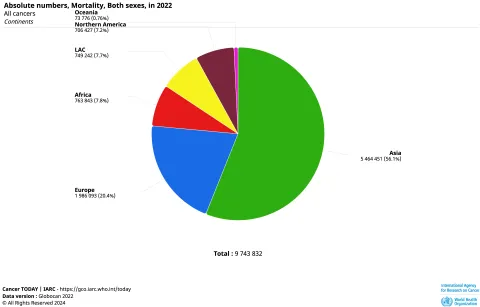GLOBOCAN 2022: Latest global cancer data shows rising incidence and stark inequities
Newly released global cancer estimates for incidence and mortality highlight significant inequities between lower and higher income regions as well as a projected significant rise in new cases in regions least equipped to deal with them.

HIGHLIGHTS
-
IARC's 2022 report shows 20 million new cancer cases and 9.7 million deaths globally, with lung and breast cancer being most common. Disparities in cancer burden and mortality exist between high and low high-development index (HDI) countries.
-
Lifestyle factors, such as smoking and diet, contribute to rising cancer cases. Preventative measures and early detection can be effective but are not widely accessible, leading to survival rate disparities, especially in breast cancer.
-
Cancer cases are projected to increase to 35 million by 2050, particularly in low and medium HDI countries, highlighting the need for improved healthcare infrastructure and access to cost-effective cancer services.
The International Agency for Research on Cancer (IARC) released its 2022 report on 1 February ahead of World Cancer Day, providing a comprehensive overview of the global cancer burden based on a survey of 115 countries.
The report reveals that there were 9.7 million deaths in 2022 (9.96 million were recorded in 2020) and 20 million new cancer cases (19.6 million in 2020). 1 in 9 men and 1 in 12 women are expected to die from cancer.
IARC cautions that these numbers are estimates for 2022 based on the best available data and do not necessarily show a trend, as previous estimates in 2020 are based on different methodologies.
What is GLOBOCAN?
GLOBOCAN is an online database providing global cancer statistics and estimates of incidence and mortality in 185 countries for 36 types of cancer, and for all cancer sites combined. The data is part of IARC’s Global Cancer Observatory, and is available online at Cancer Today with user-friendly facilities to produce maps and explore visualisations.
Lung cancer and female breast cancer are the most commonly occurring cancers worldwide (accounting respectively for 12.4% and 11.6% of total new cases), followed by colorectal cancer (9.6%), prostate cancer (7.3%) and stomach cancer (4.9%).
Lung cancer is also the leading cause of cancer deaths (18.7%) worldwide, followed by colorectal cancer (9.3%), liver cancer (7.8%), breast cancer (6.9%) and stomach cancer (6.8%). India, now the most populous country in the world, stands out as a notable exception, with oral cancers accounting for the most cancer-related deaths.
The report also sheds light on the increase in lung cancer cases. This is primarily due to smoking, however it may also in part be linked to air pollution.
Another notable change in the cancer landscape, highlighted by Dr Freddie Bray, Head of the Cancer Surveillance Branch at IARC, is the rise in colorectal cancer, now common across all development categories due to more westernised lifestyles, including diets high in red meat, alcohol consumption, and sedentary living.
Many of the most commonly diagnosed cancers are preventable by reducing exposure to risk factors such as smoking and alcohol consumption. Vaccination against human papillomavirus and hepatitis B, can also help prevent cervical cancer and liver cancer respectively. Furthermore, several cancers, including breast, colorectal and cervical cancers can now be screened for routinely and now have high rates of survival when detected and treated early.
However, these tools are not available everywhere to all populations, and a significant number of people do not have access to effective screening, diagnostics and treatment services. Indeed, the IARC report shows that while high-income countries have a higher incidence of cancer (new number of cases in a year), lower-income countries have a disproportionately higher cancer-related mortality (approximately 70%).
According to IARC, 1 in 12 women will be diagnosed with breast cancer in their lifetime and 1 in 71 women die of it in countries with a very high HDI. By contrast, in countries with a low HDI; while only one in 27 women is diagnosed with breast cancer in their lifetime, one in 48 women will die from it.
“Women in lower HDI countries are 50% less likely to be diagnosed with breast cancer than women in high HDI countries, yet they are at a much higher risk of dying of the disease due to late diagnosis and inadequate access to quality treatment.”
– Dr Isabelle Soerjomataram, Deputy Head of the Cancer Surveillance Branch at IARC
Furthermore, over 35 million new cancer cases are predicted in 2050, a 77% increase from the estimated 20 million cases in 2022, with the proportional increase in incidence most striking in low HDI countries (142% increase) and in medium HDI countries (99%). Likewise, cancer mortality in these countries is projected to almost double in 2050.
The rapidly growing global cancer burden reflects both population ageing and growth, as well as changes to people’s exposure to risk factors, several of which are associated with socioeconomic development. Tobacco, alcohol and obesity are key factors behind the increasing incidence of cancer, with air pollution still a key driver of environmental risk factors.
“These projections serve as a warning. The heaviest burden is borne by regions least enabled to deal with the increase in cancer cases. There is a critical need to invest now in workforce and infrastructure to absorb this surge.”
– Dr Freddie Bray, Head of the Cancer Surveillance Branch at IARC
André Ilbawi from WHO accentuated the potential for cost-efficient cancer interventions, stating, "Cancer does not have to be expensive," and advocated for countries to adopt WHO's best buys for cost-effective cancer services.
However, the global WHO survey on UHC and cancer shows that only 39% of participating countries covered the basics of cancer management as part of their financed core health services for all citizens, ‘health benefit packages’ (HBP).
Commenting on the data presented by IARC and WHO, Cary Adams said, “To close the equity gap and deliver services – medicines, diagnostics, treatment and care – to underserved populations is a complex problem requiring multisectoral solutions. National governments, UN agencies, civil society and the private sector must all unite in this effort.”
Last update
Monday 11 March 2024






